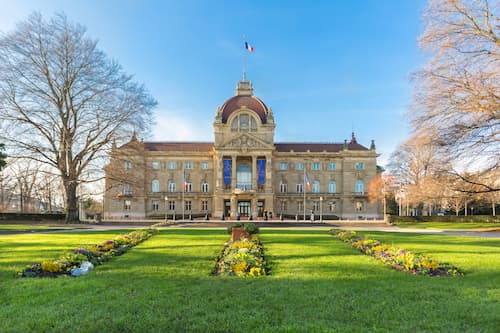
The Palais du Rhin: a national monument in the heart of Strasbourg
The Palais du Rhin (in German Kaiserpalast), the architectural pride of Strasbourg, is a former imperial palace located in the Neustadt district. It is a monument rich in history and cultural significance. This symbolic building was born in the context of the annexation of Alsace to the German Empire. Discover more about its history and its grandiose architecture.
A former imperial palace
Erected during the German period, the Palais du Rhin successively changed sovereignty, passing under the control of the French and Germans over the decades. It bears the many marks of the changes in Strasbourg's nationality during the 19th and 20th centuries.
In 1870, the city of Strasbourg suffered German bombardment. A year later, following the Treaty of Frankfurt, Alsace-Lorraine was annexed by the German Empire, victorious in the conflict. As early as 1873, the German Emperor William I expressed his desire to have a residence in the Alsatian capital. The plans were supervised by architects and influential figures of the time, including Albert Maybach, Ludwig Persius and Hermann Eggert.
However, in 1882, Chancellor Otto von Bismarck rejected the project because the construction work was too expensive. The architect Hermann Eggert then adapted his plans accordingly. The project is thus validated. The first stone was laid on March 22, 1884, the day of William I's birthday.
The inauguration of the Imperial Palace, in neo-Renaissance style, took place in August 1889, with the presence of William II of Hohenzollern, grandson of William I. The building, far from being an imperial residence, served more as a symbol of political power.
The evolution of the Palace over time
Over the years, the monument has undergone various transformations and uses. In 1920, it took the name of Palais du Rhin, when the headquarters of the Central Commission for the Navigation of the Rhine was moved from Mannheim Castle to the Palace.
It then became in turn a military hospital during the First World War, the seat of the Kommandantur during the Second World War, then the headquarters of General Leclerc.
In 1950, it was threatened with destruction in favor of a modern tower. Its Wilhelminian style sparked debate because of its architectural eclecticism. It was finally saved by the association of "Friends of Old Strasbourg".
Since 1993, it has been classified as a historical monument. Today, the Palais du Rhin still houses the Central Commission for the Navigation of the Rhine and the Regional Directorate for Cultural Affairs of the Grand Est (Drac).
An emblematic building of German architecture from the end of the 19th century
The Palais du Rhin is a magnificent example of the architectural eclecticism of the late 19th century. It takes the form of a vast quadrilateral of three levels, crowned with a square dome. The architecture of the palace is a mixture of German neo-Renaissance style and Baroque influences, inspired by the Pitti Palace in Florence, with its ashlar in yellow sandstone.
The main facade stretches over 73 meters. It is distinguished by a central avant-corps in portico, surmounted by a triangular pediment bearing the coat of arms of the Reich, as well as the monograms of Emperor William and Empress Augusta of Saxe-Weimar. Under the loggia, an eagle flanked by two baroque atlantes represents Prussia, while the coats of arms of Alsace and Lorraine adorn the external pillars. These elements embody the hierarchy of the new political order: the German Empire, Prussia, and the annexed territories.
Inside, the architecture is just as remarkable. You can admire several rooms:
- the grand staircase, lit by a huge glass roof;
- the Emperor's lounge in German Renaissance style;
- the Emperor's reception room and the Emperor's antechamber with its cameos, bas-reliefs and medallions on the ceiling;
- the Empress's lounge, rococo-inspired;
- the courtroom with its cupola, surrounded by red marble columns, opening onto the loggia.
The western part was intended for reception areas (banquet hall, dining room that can accommodate up to 350 guests and meeting room).
The Palais du Rhin is also surrounded by a large circular garden and wooded parks, enclosed by high wrought iron gates. It houses an archaeological collection comprising around twenty sarcophagi and elements of ancient monuments from the Strasbourg necropolis.
It is enriched with sculptures, including a work of art by René Hetzel in the north parterre, and a celestial scale in white granite by Annie Greiner, in homage to the Czech philosopher Jan Patocka.
In 2017, this prestigious building was listed as a UNESCO World Heritage Site.
Practical information on the Palais du Rhin in Neustadt
The Palais du Rhin is located on the former Place de l'Empereur, now Place de la République, in the Neustadt district. To reach it, favor public transport:
- tram B, C, E or F - République stop;
- bus 15a or 72 - République stop.
From the Strasbourg Cathedral, it is only about ten minutes' walk away.
Free guided and commented tours are available during the European Heritage Days. In addition, the palace regularly hosts artistic and cultural exhibitions.
During your visit to the Palais du Rhin, take the opportunity to discover the post-Haussmann district of Neustadt. It is full of Prussian-style buildings and architectural treasures.
Then, join us at the B&B HOTEL Strasbourg Nord Schiltigheim, less than 3 km away, for a comfortable night. We look forward to welcoming you for your stay in the Alsatian capital!




















